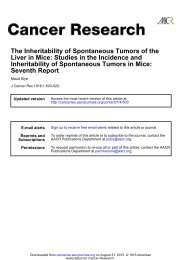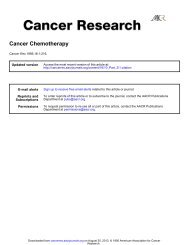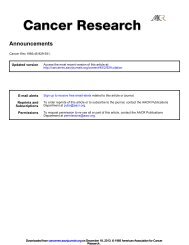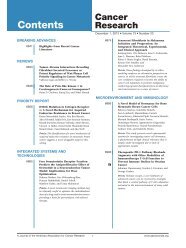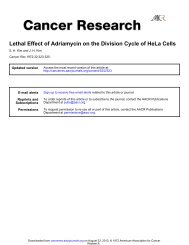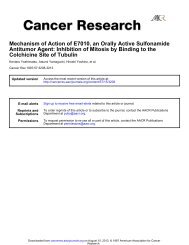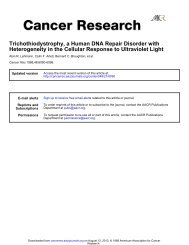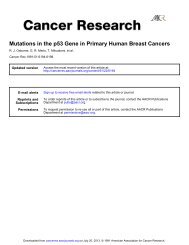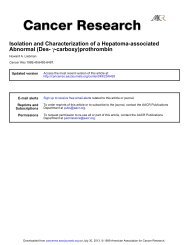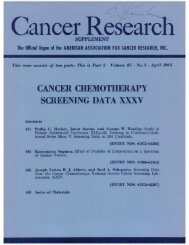XANTHOMA OF THE BREAST In a series of nine hundred (circa ...
XANTHOMA OF THE BREAST In a series of nine hundred (circa ...
XANTHOMA OF THE BREAST In a series of nine hundred (circa ...
Create successful ePaper yourself
Turn your PDF publications into a flip-book with our unique Google optimized e-Paper software.
Downloaded from cancerres.aacrjournals.org on December 28, 2013. © 1932<br />
American Association for Cancer Research.<br />
1100 CUSHMAN D. HAAGENSEN<br />
surface application <strong>of</strong> radium, nor intravenous thorium-X affected<br />
the progressive course <strong>of</strong> the disease. MacKee treated one case <strong>of</strong><br />
xanthoma tuberosum, one <strong>of</strong> xanthoma planum, and another <strong>of</strong><br />
xanthoma diabeticorum with roentgen rays without success. He<br />
also failed to secure regression in a case <strong>of</strong> xanthoma palpebrarum<br />
which he treated with beta rays <strong>of</strong> radium. Sosman treated one<br />
doubtful and two probable cases <strong>of</strong> Christian's-Schtiller's disease<br />
with roentgen rays. Although dietary treatment had produced no<br />
change in the skull defects in these cases the roentgen treatment<br />
was promptly followed by repair. <strong>In</strong> the <strong>series</strong> <strong>of</strong> cases <strong>of</strong> primary<br />
xanthoma <strong>of</strong> the breast reported herewith the two tumors which<br />
were irradiated were certainly moderately radiosensitive. <strong>In</strong> Case<br />
1, which received preoperative interstitial radium treatment, the<br />
diminution in the size <strong>of</strong> the tumor is well illustrated by comparison<br />
<strong>of</strong> Figs. 1 and 2, which show the lesion before and after radiation.<br />
<strong>In</strong> Case 2 the tumor distinctly diminished in size under preoperative<br />
roentgen treatment.<br />
<strong>In</strong> the face <strong>of</strong> the fact that there seems to be no way <strong>of</strong> diagnosing<br />
primary xanthoma <strong>of</strong> the breast clinically, the proper procedure<br />
when such a lesion is suspected is biopsy. If the yellow color <strong>of</strong> the<br />
gross specimen does not make the diagnosis <strong>of</strong> primary xanthoma<br />
sure, however, it is probable that not much help will be obtained<br />
from frozen sections. Since primary xanthoma <strong>of</strong> the breast has<br />
not been described before, except for Cheatle's brief report <strong>of</strong> his<br />
case, in which the diagnosis was suggested by the yellow color <strong>of</strong><br />
the gross specimen and was confirmed by routine sections, no<br />
observations as to experience with frozen section diagnosis are<br />
available. Frozen sections were not done in the three cases <strong>of</strong><br />
primary xanthoma which are the subject <strong>of</strong> the present report.<br />
From his knowledge <strong>of</strong> their histology the writer suspects that it<br />
would be very difficult indeed to distinguish in frozen sections these<br />
tumors from certain large-celled types <strong>of</strong> carcinoma <strong>of</strong> the breast.<br />
<strong>In</strong> such a dilemma the surgeon would have no alternative but to<br />
proceed with radical mastectomy.<br />
<strong>In</strong> the diagnosis <strong>of</strong> secondary xanthomatous degeneration in<br />
true neoplasms, inflammatory processes, and traumatic fat necrosis<br />
<strong>of</strong> the breast, frozen sections are invaluable. Here the general<br />
histologic structure <strong>of</strong> the lesion should distinguish it from carcinoma.<br />
Traumatic fat necrosis in the repair stage may <strong>of</strong>fer very<br />
great difficulty, however. Keynes reports that in his case the<br />
lesion was mistaken in the frozen section for carcinoma and a



